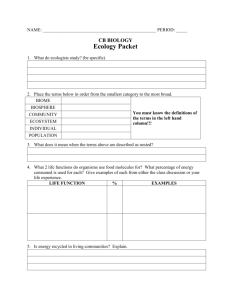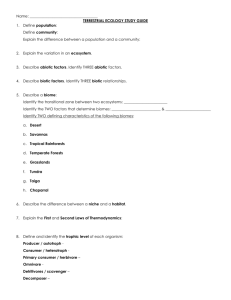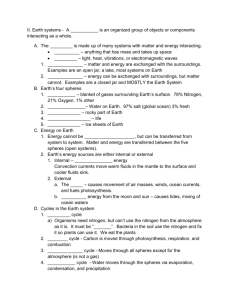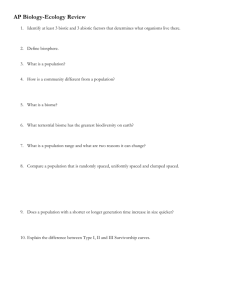Chapter 47
advertisement
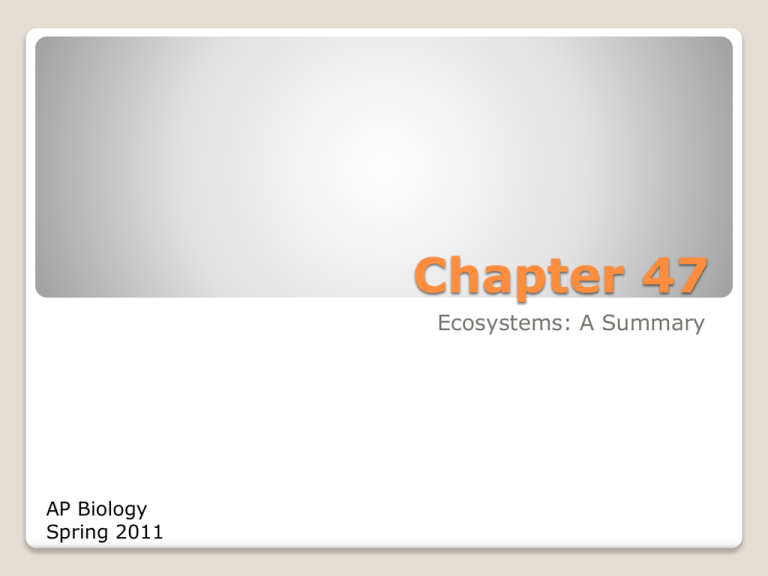
Chapter 47 Ecosystems: A Summary AP Biology Spring 2011 Ecosystem is the sum of the organisms residing there and the environment Nature of Ecosystems Primary producer: plant that serves as an autotroph by harnessing sun’s energy Consumer: animal or heterotroph that derives energy from consuming plants or other animals Nature of Ecosystems Detrivore: animal that consumes debris and small bits of organic matter Decomposer: eats wastes and remains of plants and animals Nature of Ecosystems Minerals: increase and decrease in natural cycles The organisms of an ecosystem develop trophic levels ◦ Food chain represents passage of energy from one trophic level to the next Nature of Ecosystems Tropic Levels A food web is a complex interaction among species of the ecosystem ◦ In a grazing food chain, the energy goes from producers to consumers ◦ In a detrital food chain, energy goes from producers to detrivores to decomposers An alteration in one species of a food web may affect many different organisms The Nature of Food Webs Food Web Primary production: rate at which plants harness the sun’s energy ◦ Depends on availability of water and nutrients ◦ Is higher on land than water Energy Flow Through Ecosystem Biomass pyramid: used as a tool to represent dry weight of the organisms at each trophic level ◦ Plants or producers make up the base of the pyramid ◦ Consumers make up the upper portion of the pyramid with the largest carnivores at the very top Energy Flow Through Ecosystem Energy pyramid: shoes how energy is lost when transferred to each trophic level ◦ Energy transfer in watery ecosystems is usually more efficient than those on land Energy Flow Through Ecosystem The effects of dangerous chemicals can become intensified as they move up the food chain ◦ An insecticide called DDT resulted in the deaths of birds and other animals Book “Silent Spring” by Rachel Carson, brought this problem to public’s attention ◦ Mercury from various industries enters the water supply and becomes intensified in fish Biological Megnification Biogeochemical Cycles: nutrients move through environmental stores and living organisms ◦ Elements enter living portion of cycle by becoming incorporated into plants ◦ Ex. Water, carbon, nitrogen, phosphorous cycles Biogeochemical Cycles Water cycle: begins when water evaporates from bodies of water and transpiration occurs in plants ◦ Water condenses in clouds and rains down ◦ Water collects in watersheds, aquifers and in groundwater Future water supply may be ocean through utilization of a desalinization process to remove salts Water Cycle Water Cycle Carbon cycle: most contained in earth’s crust ◦ Carbon in ocean is originally formed from shells of small organisms ◦ Crust lifts up eventually and becomes part of land mass Carbon Cycle Diffusion takes place between carbon in atmosphere and that in ocean There is a loop-like current which delivers carbon dioxide to ocean reservoir Carbon changes from between carbon dioxide and bicarbonate Carbon Cycle Man adversely affects carbon cycle by releasing more carbon into air contributing to global warming Carbon Cycle Main gases that contribute to greenhouse effect are: carbon dioxide, water, nitrous oxide, methane, and chlorofluorocarbons Suns heat is absorbed by earth’s surface Some of heat is reflected back into atmosphere, but atmospheric gases send some heat back to earth Greenhouse Gases and Climate Change Greenhouse effect: heat builds up in lower atmosphere, the air temperature near Earth’s surface rises ◦ Natural necessary phenomenon to maintain reasonable temperatures on earth ◦ Increase in greenhouse gases is creating abnormal global warming ◦ Global warming is causing warmer ocean temperature which result in melting glaciers and more severe storms Greenhouse Gases and Climate Change Nitrogen exists in atmosphere as N2 which is not in a usable form for plants ◦ Some natural processes such as lightening and volcanoes can convert the nitrogen to a usable form Nitrogen Cycle The bacteria Rhizobium that exists in nodules on legumes also converts the nitrogen to a usable form ◦ Nitrogen changes from N2 to NH3 which then converts to NH4+ and NO3-, which are able to be used by plants Nitrogen Cycle Manmade interference helps to denitrify the ecosystem ◦ The leaching of water through the soil and the absence of crop rotation help to deplete the soil of nitrogen When fertilizers run off into water sources, it causes algae blooms which are disadvantageous to animal species Nitrogen Cycle Nitrogen Cycle Phosphorous cycles between land and ocean ◦ Phosphates are necessary for major cellular components like nucleic acids, plasma membranes and ATP Phosphorous Cycle Plants get phosphorous from the water and soil Animals get it from consuming plants or other animals ◦ Phosphorous levels are quite often a limiting factor for plant growth ◦ Lock of phosphorous in soil can be due to absence of crop rotation Phosphorous Cycle An excess of phosphorous can result from water that runs off from fertilized fields ◦ Excessive amounts of phosphorous in watery environment can cause eutrophication ◦ Algae bloom occurs that harms plant and animal species ◦ Difficult to reverse Phosphorous Cycle
